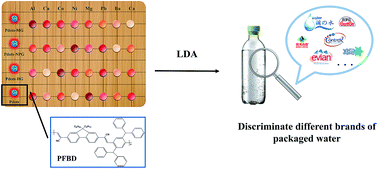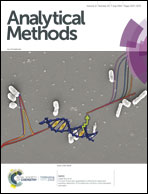Development of a fluorescence sensor array for the discrimination of metal ions and brands of packaged water based on gallate-modified polymer dots†
Abstract
Because of the appearance of many counterfeit products in the packaged water market, it is necessary to find an efficient method to discriminate different brands of packaged water. Furthermore, distinguishing counterfeit packaged water is of vital importance to human health. In this work, a sensitive fluorescence sensor array based on polymer dots doped with gallates was established in a convenient way. Three gallate compounds, namely, methyl gallate, n-propyl gallate, and dodecyl gallate were assembled on polymer dots, which generated different binding abilities to various metal ions. According to the differences, we established the fingerprint of metal ions and a sensor array, realizing the discrimination of eight representative metal ions. More importantly, we could distinguish different brands of packaged water from each other. Various packaged water samples appeared in different areas in the canonical score plots for the response patterns. Furthermore, in the blind experiment, we successfully discriminated 24 samples with 100% accuracy. This sensor array is significant for the development of packaged water market and for ensuring the customer's health. Moreover, it will have good application prospects both in the market and for families.

- This article is part of the themed collection: Analytical Methods Recent HOT articles


 Please wait while we load your content...
Please wait while we load your content...